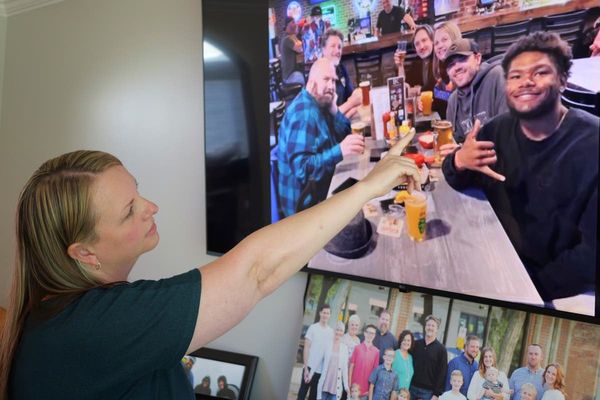
A deep growl rumbles in Dipsy's throat as the open wounds across his body are treated with cream and antibiotics.
Like a burn victim, he's covered in painful sores, lesions, and matted hair.
The adult bare-nosed wombat was found underneath a pizza oven suffering from mange - a disease similar to scabies in humans.
A burrowing mite called Sarcoptes Scabei is the cause and when it finds a home in wombat fur it lays up to four eggs per day, causing an immune reaction that can be fatal.
"It's predominantly an animal welfare issue because it causes really severe disease that usually leads to mortality ... over about a three-month period," says Scott Carver, one of Australia's foremost researchers on wombats.
"So they lose hair, their skin thickens up and because they're investing so much into their immune response, they become emaciated," he added.
"They go through a lot of suffering, they change their foraging and behaviour as a consequence of it."
Dr Carver and his team at the University of Tasmania have received a research grant to survey wombat populations in NSW and to learn what environmental factors make wombats more or less susceptible to mange.
A total of $2.8 million in funding announced by the NSW government in July is aimed at curbing the disease across the state.
Licensed NSW wildlife rehabilitation and Aboriginal community groups will be able to access money to buy equipment and medication to treat mange-affected wombats.
"There's still lots we have to learn," Dr Carver said.
His research will include a study on the best way to treat mange using two drugs, Cydectin and Bravecto.
Yolandi Vermaak, the founder of Wombat Rescue NSW/ACT, said the organisation is getting more and more calls to help wombats with mange.
She was the one who rescued Dipsy and despite providing round-the-clock care, is not sure if will be enough.
"The emotional toll it takes - every time I lift the lid of the box, I'm wondering if he's going to be alive or not," she said.
Ms Vermaak said the fact wombats live in underground burrows means it's harder to treat as the conditions lengthen the lifespan of the mange mite.

Dr Carver's research points to this being crucial to the spread of the disease.
"(Wombats) switch burrows every one to 10 days, and so we think transmission happens in the burrow via the environment when one comes in and another leaves," he said.
He likened it to the spread of bed bugs if sheets and bedding are not washed and changed regularly.
John Grant, a spokesperson at the Wildlife Information Rescue & Education Service (WIRES), said of the 1656 wombat-related calls received in the 2022/23 financial year, nearly 40 per cent were mange-related.
"Mange is the biggest threat to wombats in NSW," said Mr Grant, who estimates 90 per cent of wombat populations in the state were affected by the disease.
The service launched a community treatment program to enable individuals to treat wombats found on private properties, which works in conjunction with a National Parks and Wildlife Service app that volunteers can use to report numbers and treatment of affected wombats.
Although it is contributing to localised population decline, Dr Carver said mange was not an extinction threat for the mostly nocturnal mammals.

Most wombats suffering from mange are silent because of the threat from predators, Ms Vermaak said.
"Wild wombats wouldn't make a sound," she said. "You wouldn't know they are in pain."
Thanks to her care, however, Dipsy has turned a corner, eating grass again instead of only fluids and gaining weight.
The raw wounds across his body are healing, and Ms Vermaak is hopeful of a full recovery.
WIRES 1300 094 737







